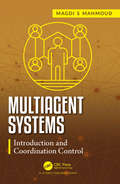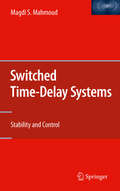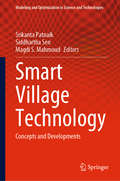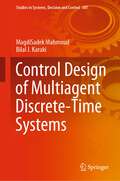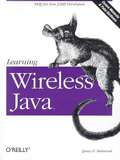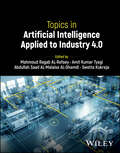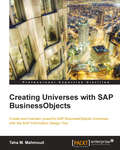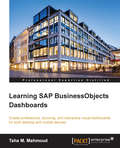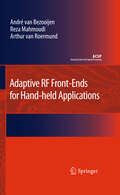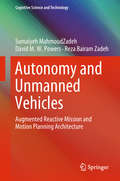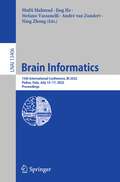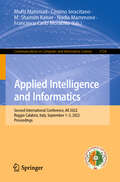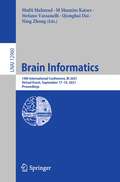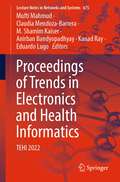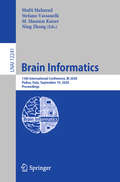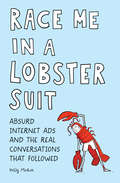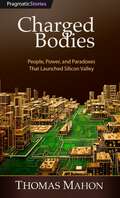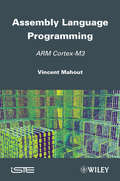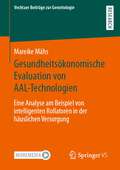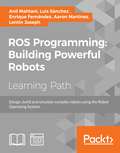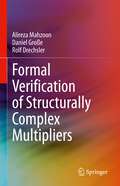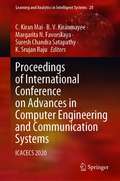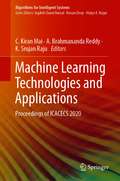- Table View
- List View
Multiagent Systems: Introduction and Coordination Control
by Magdi S. MahmoudMultiagent systems (MAS) are one of the most exciting and the fastest growing domains in the intelligent resource management and agent-oriented technology, which deals with modeling of autonomous decisions making entities. Recent developments have produced very encouraging results in the novel approach of handling multiplayer interactive systems. In particular, the multiagent system approach is adapted to model, control, manage or test the operations and management of several system applications including multi-vehicles, microgrids, multi-robots, where agents represent individual entities in the network. Each participant is modeled as an autonomous participant with independent strategies and responses to outcomes. They are able to operate autonomously and interact pro-actively with their environment. In recent works, the problem of information consensus is addressed, where a team of vehicles communicate with each other to agree on key pieces of information that enable them to work together in a coordinated fashion. The problem is challenging because communication channels have limited range and there are possibilities of fading and dropout. The book comprises chapters on synchronization and consensus in multiagent systems. It shows that the joint presentation of synchronization and consensus enables readers to learn about similarities and differences of both concepts. It reviews the cooperative control of multi-agent dynamical systems interconnected by a communication network topology. Using the terminology of cooperative control, each system is endowed with its own state variable and dynamics. A fundamental problem in multi-agent dynamical systems on networks is the design of distributed protocols that guarantee consensus or synchronization in the sense that the states of all the systems reach the same value. It is evident from the results that research in multiagent systems offer opportunities for further developments in theoretical, simulation and implementations. This book attempts to fill this gap and aims at presenting a comprehensive volume that documents theoretical aspects and practical applications.
Switched Time-Delay Systems
by Magdi S. MahmoudThis book is about stability analysis and control design methodologies for a new class of systems, switched time-delay systems (STDs). The author presents an introductory, yet comprehensive, treatment of STD systems by jointly combining the two fundamental attributes: the system dynamics which possesses an inherent time-delay and the system operational mode which undergoes switching among different modes. The material integrates the two main issues of switched systems in a systematic way.
Smart Village Technology: Concepts and Developments (Modeling and Optimization in Science and Technologies #17)
by Magdi S. Mahmoud Siddhartha Sen Srikanta PatnaikThis book offers a transdisciplinary perspective on the concept of "smart villages" Written by an authoritative group of scholars, it discusses various aspects that are essential to fostering the development of successful smart villages. Presenting cutting-edge technologies, such as big data and the Internet-of-Things, and showing how they have been successfully applied to promote rural development, it also addresses important policy and sustainability issues. As such, this book offers a timely snapshot of the state-of-the-art in smart village research and practice.
Control Design of Multiagent Discrete-Time Systems (Studies in Systems, Decision and Control #387)
by MagdiSadek Mahmoud Bilal J. KarakiThis book describes an effective approach to the cooperative and coordinated control of multivehicle systems. This rigorous analytic approach guarantees the stability of coordinated and cooperating vehicles using distributed protocols and uses low-energy, event-triggered mechanisms for networked vehicle control. The text covers: design of a cooperative protocol to achieve consensus for multivehicle systems, allowing cooperation that is resistant to the effects of packet loss and/or adversarial attack; analysis and synthesis of an event-triggering mechanism for cooperative multivehicle systems over uncertain networks; and the problem of distributed leader-following consensus and methods for compelling multivehicle systems to reach consensus. Throughout the book, cooperation problems are transformed into stability problems. Lyapunov theory is used to guarantee cooperation among agents. The distributed approach is applied to triggering mechanisms, the cooperation process, and the impact of cyber-attacks. Discrete-time analysis shows how the event-based structure can be designed to match the performance of continuous-time counterparts. The book details applications and computer simulation with several practical examples. This book is of interest to a wide audience from the graduate student, through the academic researcher to the industrial practitioner, all of them sharing a common interest in the stability and security of multiagent systems.
Learning Wireless Java
by Qusay MahmoudLearning Wireless Java is for Java developers who want to create applications for the Micro Edition audience using the Connected, Limited Device Configuration and the Mobile Information Device Profile (MIDP). These APIs specifically for devices such as mobile phones and pagers, allowing programmers to create MIDlet applications. This book offers a solid introduction to J2ME and MIDP, including the javax.microedition classes, as well as classes surrounding the features of the various platforms that the J2ME
Wireless Java
by Qusay MahmoudLearning Wireless Java is for Java developers who want to quickly come up to speed and create applications for the Micro Edition audience. This book covers the Connected, Limited Device Configuration and the Mobile Information Device Profile (MIDP), both currently available from Javasoft. The CLDC contains APIs for small devices that are constrained by both memory and processing power. MIDP builds on top of the CLDC and adds APIs specifically for devices such as mobile phones and pagers, allowing programmers to create MIDlet applications. This book offers a solid introduction to J2ME and MIDP, including an explanation of the J2ME Wireless Toolkit, the MIDlet lifecycle methods, the Java application manager, and the CLDC and MIDP constraints. In addition, we cover the javax.microedition.io, javax.microedition.rms, javax.microedition.lcdui, and javax.microedition.midlet classes, as well as the modified java.lang, java.io, and java.util classes. Discussion centers around building safe, compact applications with the sophisticated graphical interface, database, and networking capabilities that the J2ME supports. In addition, this book also shows you how to download your applications to the latest J2ME-enabled devices, including the Motorola i50x and i85s phones and upgraded Palm handhelds.
Topics in Artificial Intelligence Applied to Industry 4.0
by Mahmoud Ragab AL-Refaey Amit Kumar Tyagi Abdullah Saad AL-Malaise Swetta KukrejaTopics in Artificial Intelligence Applied to Industry 4.0 Forward thinking resource discussing emerging AI and IoT technologies and how they are applied to Industry 4.0 Topics in Artificial Intelligence Applied to Industry 4.0 discusses the design principles, technologies, and applications of emerging AI and IoT solutions on Industry 4.0, explaining how to make improvements in infrastructure through emerging technologies. Providing a clear connection with different technologies such as IoT, Big Data, AR and VR, and Blockchain, this book presents security, privacy, trust, and other issues whilst delving into real-world problems and case studies. The text takes a highly practical approach, with a clear insight on how readers can increase productivity by drastically shortening the time period between the development of a new product and its delivery to customers in the market by 50%. This book also discusses how to save energy across systems to ensure competitiveness in a global market, and become more responsive in how they produce products and services for their consumers, such as by investing in flexible production lines. Written by highly qualified authors, Topics in Artificial Intelligence Applied to Industry 4.0 explores sample topics such as: Quantum machine learning, neural network implementation, and cloud and data analytics for effective analysis of industrial data Computer vision, emerging networking technologies, industrial data spaces, and an industry vision for 2030 in both developing and developed nations Novel or improved nature-inspired optimization algorithms in enhancing Industry 5.0 and the connectivity of any components for smart environment Future professions in agriculture, medicine, education, fitness, R&D, and transport and communication as a result of new technologies Aimed at researchers and students in the interdisciplinary fields of Smart Manufacturing and Smart Applications, Topics in Artificial Intelligence Applied to Industry 4.0 provides the perfect overview of technology from the perspective of modern society and operational environment.
Creating Universes with SAP BusinessObjects
by Taha M. MahmoudThis book is aimed at both new developers as well as experienced developers. If you are a new SAP BusinessObjects Universe developer who is looking for a step-by-step guide supported with real-life examples and illustrated diagrams, then this book is for you. If you are a seasoned BusinessObjects Universe developer who is looking for a fast way to map your old experience in Universe designer to the newer Information Design Tool, then this book is for you as well.
Learning SAP BusinessObjects Dashboards
by Taha M. MahmoudThis book will help beginners to create stylish and professional looking dashboards in no time. It is also intended for BI developers who want to use SAP BO to facilitate BI in their organizations. No prior knowledge is required, however, you must have a basic knowledge of MS Excel and some analytical skills to build expressive business charts.
Adaptive RF Front-Ends for Hand-held Applications (Analog Circuits and Signal Processing)
by Reza Mahmoudi Arthur H.M. van Roermund Andre Van BezooijenThe RF front-end - antenna combination is a vital part of a mobile phone because its performance is very relevant to the link quality between hand-set and cellular network base-stations. The RF front-end performance suffers from changes in operating environment, like hand-effects, that are often unpredictable. Adaptive RF Front-Ends for Hand-Held Applications presents an analysis on the impact of fluctuating environmental parameters. In order to overcome undesired behavior two different adaptive control methods are treated that make RF frond-ends more resilient: adaptive impedance control, and adaptive power control. Several adaptive impedance control techniques are discussed, using a priori knowledge on matching network properties, in order to simplify robust 2-dimensional control. A generic protection concept is presented, based on adaptive power control, which improves the ruggedness of a power amplifier or preserves its linearity under extremes. It comprises over-voltage, over-temperature, and under-voltage protection.
Autonomy and Unmanned Vehicles: Augmented Reactive Mission And Motion Planning Architecture (Cognitive Science And Technology Ser.)
by Somaiyeh MahmoudZadeh Reza Bairam Zadeh David M.W. PowersThis book addresses higher–lower level decision autonomy for autonomous vehicles, and discusses the addition of a novel architecture to cover both levels. The proposed framework’s performance and stability are subsequently investigated by employing different meta-heuristic algorithms. The performance of the proposed architecture is shown to be largely independent of the algorithms employed; the use of diverse algorithms (subjected to the real-time performance of the algorithm) does not negatively affect the system’s real-time performance. By analyzing the simulation results, the book demonstrates that the proposed model provides perfect mission timing and task management, while also guaranteeing secure deployment. Although mainly intended as a research work, the book’s review chapters and the new approaches developed here are also suitable for use in courses for advanced undergraduate or graduate students.
Brain Informatics: 15th International Conference, BI 2022, Padua, Italy, July 15–17, 2022, Proceedings (Lecture Notes in Computer Science #13406)
by Mufti Mahmud Jing He Stefano Vassanelli André Van Zundert Ning ZhongThis book constitutes the refereed proceedings of the 15th International Conference on Brain Informatics, BI 2022, held as hybrid event in Padua, Italy (in person) and Queensland, Australia (online) in July 2022. The 29 papers were selected from 65 submissions and the main theme of BI 2022 is Brain Science meets Artificial Intelligence with respect to the five tracks: Cognitive and computational foundations of brain science; human information processing systems; brain big data analytics, curation and management; informatics paradigms for brain and mental health research; and brain-machine intelligence and brain inspired computing.
Applied Intelligence and Informatics: Second International Conference, AII 2022, Reggio Calabria, Italy, September 1–3, 2022, Proceedings (Communications in Computer and Information Science #1724)
by Mufti Mahmud Cosimo Ieracitano M. Shamim Kaiser Nadia Mammone Francesco Carlo MorabitoThis book constitutes the refereed proceedings of the Second International Conference on Applied Intelligence and Informatics, AII 2022, held in Reggio Calabria, Italy, during September 1–3, 2022. The 38 full papers included in this book were carefully reviewed and selected from 108 submissions. They were organized in topical sections as follows: Emerging Applications of AI and Informatics; Application of AI and Informatics in Healthcare; Application of AI and Informatics in Pattern Recognition; and Application of AI and Informatics in Network, Security, and Analytics.
Brain Informatics: 14th International Conference, BI 2021, Virtual Event, September 17–19, 2021, Proceedings (Lecture Notes in Computer Science #12960)
by Mufti Mahmud M Shamim Kaiser Stefano Vassanelli Qionghai Dai Ning ZhongThis book constitutes the refereed proceedings of the 14th International Conference on Brain Informatics, BI 2021, held in September 2021. The conference was held virtually due to the COVID-19 pandemic. The 49 full and 2 short papers together with 18 abstract papers were carefully reviewed and selected from 90 submissions. The papers are organized in the following topical sections: cognitive and computational foundations of brain science; investigations of human information processing systems; brain big data analytics, curation and management; informatics paradigms for brain and mental health research; and brain-machine intelligence and brain-inspired computing.
Proceedings of Trends in Electronics and Health Informatics: TEHI 2022 (Lecture Notes in Networks and Systems #675)
by Mufti Mahmud Claudia Mendoza-Barrera M. Shamim Kaiser Anirban Bandyopadhyay Kanad Ray Eduardo LugoThis book includes selected peer-reviewed papers presented at the International Conference on Trends in Electronics and Health Informatics (TEHI 2022), held at University of Puebla, Puebla, México, during December 7–9, 2022. The book is broadly divided into five sections—artificial intelligence and soft computing, healthcare informatics, Internet of things and data analytics, electronics, and communications.
Brain Informatics: 13th International Conference, BI 2020, Padua, Italy, September 19, 2020, Proceedings (Lecture Notes in Computer Science #12241)
by Mufti Mahmud Stefano Vassanelli M. Shamim Kaiser Ning ZhongThis book constitutes the refereed proceedings of the 13th International Conference on Brain Informatics, BI 2020, held in Padua, Italy, in September 2020. The conference was held virtually due to the COVID-19 pandemic. The 33 full papers were carefully reviewed and selected from 57 submissions. The papers are organized in the following topical sections: cognitive and computational foundations of brain science; investigations of human information processing systems; brain big data analytics, curation and management; informatics paradigms for brain and mental health research; and brain-machine intelligence and brain-inspired computing.
Race Me in a Lobster Suit: Absurd Internet Ads and the Real Conversations that Followed
by Kelly MahonThis collection of prank Craigslist ads and the real email exchanges that followed is the perfect gift for fans of offbeat humor. When New York City copywriter Kelly Mahon started posting fake gig ads online as a creative outlet, she was surprised to find that there was someone interested in every bizarre job offer she dreamed up. Race Me in a Lobster Suit collects Mahon’s funniest posts, along with the improvised email exchanges with would-be cocoon knitters and lobster racers. Some correspondents became suspicious, while others seemed willing to play along. The result is good-natured comedy gold and a kind of collaborative entertainment that could only exist in the internet gig economy. Irreverent illustrations by cartoonist Graham Annable (creator of the Harvey Award nominated Grickle comics) ensure that this small book offers outsize laughs. A quick, hilarious read, Race Me in a Lobster Suit is perfect for anyone who needs a bit of absurdity to brighten their day.
Charged Bodies: People, Power, And Paradox In Silicon Valley
by Thomas MahonAt the heart of Silicon Valley's meteoric rise is a story etched in the lives of those who shaped it and those who were forever transformed by it. Author Tom Mahon provides an insider's perspective on the birth of the semiconductor industry, which sparked the region's transformation from sleepy farmland to the heart and soul of the high-tech revolution. Through twenty-five extended, in-person interviews you'll meet a diverse cast of characters whose goal was to create technology and tools in service to humanity. In the Afterword to this edition, the author questions whether they accomplished their objectives and urges readers to rise up and rethink technology. What did it take to create the atmosphere that transformed rich farmland into the wealthy center of high-tech? Five climates lined up in just the right way. Educational institutions (Stanford and Berkeley); an attractive location with balmy, Mediterranean-like weather; a history of technology development (Federal Telegraph in the early twentieth century); financial risk taking (the gold rush); and a cultural climate near the center of an ideological revolution (the hippie movement). The Santa Clara Valley had them all. In spades. Before personal computers, or the Internet, or social media came *chips*. Inventive minds took advantage of the quad-electron structure and unique properties - insulative and conductive - of silicon to create semiconductors. But Charged Bodies is more than just the story of new technologies emerging from "The Valley of the Heart's Delight." Using an approach like The Canterbury Tales, Tom Mahon captures the spirit of Silicon Valley in the 80s through the stories of the people all around him. The inventors and bankers have their say. But so do a range of other people who lived through that transition. Listen as artists and hackers, detectives and journalists, lawyers and scientists, flappers and philosophers tell the story of Silicon Valley in their own words.
The Eleventh Off-Campus Library Services Conference Proceedings
by Patrick MahoneyLearn how to provide better service to distance information users! This book is the result of the conference held in May, 2004 in Scottsdale, Arizona, focusing on librarians' challenges providing service to nontraditional faculty and students. Respected authorities discuss in detail specific problems-and fresh strategies and solutions-to further promote service to distance information users. Each chapter tackles a particular issue such as collaboration outside the contributor's organization or how services can be monitored and assessed to gauge quality, and fully explains what can be done to address those issues. Each distinguished contribution was carefully selected by a 26-member advisory board using a juried abstracts process. Thorough bibliographies, useful figures, tables, and graphs provide accessibility and clarify ideas. Some of the topics in this book include: the promotion of library services to Native American students the planning and development process of a project to create a Web-based multi-media instruction tool for off-campus graduate students an examination of direct linking tools provided by major aggregators distance learning for the learning disabled distance learning implementation strategies for institutions course management software (CMS) and library services integration a survey of Association of Research Libraries offered services the do&’s and don&’ts of videoconferencing on and off-campus an eBooks collection study one-on-one research coaching via digital reference service an online tool that assesses students&’ research skills and attitudes creating a library CD for off-campus students expanding student and faculty access to information services the collaboration with faculty on electronic course reserves developing assessment questions for services supporting off-campus learning programs providing secure off-campus access to library services beyond proxy servers and much, much more!The Eleventh Off-Campus Library Services Conference Proceedings is an invaluable comprehensive resource detailing the latest challenges and solutions for on- and off-campus librarians.
Assembly Language Programming: ARM Cortex-M3
by Vincent MahoutARM designs the cores of microcontrollers which equip most "embedded systems" based on 32-bit processors. Cortex M3 is one of these designs, recently developed by ARM with microcontroller applications in mind. To conceive a particularly optimized piece of software (as is often the case in the world of embedded systems) it is often necessary to know how to program in an assembly language. This book explains the basics of programming in an assembly language, while being based on the architecture of Cortex M3 in detail and developing many examples. It is written for people who have never programmed in an assembly language and is thus didactic and progresses step by step by defining the concepts necessary to acquiring a good understanding of these techniques.
Gesundheitsökonomische Evaluation von AAL-Technologien: Eine Analyse am Beispiel von intelligenten Rollatoren in der häuslichen Versorgung (Vechtaer Beiträge zur Gerontologie)
by Mareike MähsUm die Informationsbasis über AAL-Technologien zu erhöhen, wird Wissen über die Effektivität, den Nutzen und die Kosten dieser Technologien benötigt. Es fehlen jedoch gerade für AAL-Technologien qualitativ hochwertige gesundheitsökonomische Evaluationsstudien. Die vorliegende Arbeit hat deshalb das Ziel, gesundheitsökonomische Evaluationsverfahren hinsichtlich ihres Einsatzes zur Abschätzung der Wirksamkeit und Wirtschaftlichkeit von AAL-Technologien zu untersuchen und eine geeignete Vorgehensweise zur Evaluationen von AAL-Technologien am Beispiel von intelligenten Rollatoren aufzuzeigen. Mareike Mähs zeigt, dass eine gesundheitsökonomische Evaluation von AAL-Technologien mit spezifischen Herausforderungen einhergeht. Dementsprechend sind vorhandene Verfahren an die Charakteristika der Technologie und ihrer Nutzerinnen sowie Nutzer anzupassen bzw. alternative Verfahren zu wählen. Aus diesem Grund wird ein Framework entwickelt, das eine Orientierung für eine strukturierte Vorgehensweise zur entwicklungsbegleitenden Evaluation von AAL-Technologien am Beispiel von intelligenten Rollatoren entlang deren Lebenszyklus bietet.
ROS Programming: Design, build and simulate complex robots using the Robot Operating System
by Anil Mahtani Luis Sanchez Enrique Fernandez Aaron Martinez Lentin JosephEnhancing your existing robotic skills by learning how to design and build multifunctional robots using Robots Operating System libraries and tools About This Book • Successfully design and simulate your 3D robot model and use powerful algorithms and tools to program and set up your robots • Work through concrete examples that will help you build your own robotic systems of varying complexity levels • Discover the best practices and troubleshooting solutions everyone needs when working on ROS Who This Book Is For This course targets robotic enthusiasts, developers, and researchers who would like to build robot applications using ROS. If you are looking to explore the advanced ROS features in your projects, then this learning path is for you. Basic knowledge of ROS, GNU/Linux, and programming concepts is assumed. What You Will Learn • Understand the concepts of ROS, the command-line tools, visualization GUIs, and how to debug ROS • Connect robot sensors and actuators to ROS • Obtain and analyze data from cameras and 3D sensors • Dig deep into the ROS Pluginlib, ROS nodelets, and Gazebo plugins • Interface I/O boards such as Arduino, robot sensors, and high-end actuators with ROS • Get to grips with teleoperating robots using hand gestures • Build ROS-based applications using Matlab and Android • Build interactive applications using TurtleBot In Detail This learning path is designed to help you program and build your robots using open source ROS libraries and tools. We start with the installation and basic concepts, then continue with the more complex modules available in ROS, such as sensor and actuator integration (drivers), navigation and mapping (so you can create an autonomous mobile robot), manipulation, computer vision, perception in 3D with PCL, and more. We then discuss advanced concepts in robotics and how to program using ROS. You'll get a deep overview of the ROS framework, which will give you a clear idea of how ROS really works. During the course of the book, you will learn how to build models of complex robots, and simulate and interface the robot using the ROS MoveIt motion planning library and ROS navigation stacks. We'll go through great projects such as building a self-driving car, an autonomous mobile robot, and image recognition using deep learning and ROS. You can find beginner, intermediate, and expert ROS robotics applications inside! It includes content from the following Packt products: • Effective Robotics Programming with ROS - Third Edition • Mastering ROS for Robotics Programming • ROS Robotics Projects Style and approach This course is packed with fun-filled, end-to-end projects on mobile, armed, and flying robots, and describes the ROS implementation and execution of these models.
Formal Verification of Structurally Complex Multipliers
by Alireza Mahzoon Daniel Große Rolf DrechslerThis book addresses the challenging tasks of verifying and debugging structurally complex multipliers. In the area of verification, the authors first investigate the challenges of Symbolic Computer Algebra (SCA)-based verification, when it comes to proving the correctness of multipliers. They then describe three techniques to improve and extend SCA: vanishing monomials removal, reverse engineering, and dynamic backward rewriting. This enables readers to verify a wide variety of multipliers, including highly complex and optimized industrial benchmarks. The authors also describe a complete debugging flow, including bug localization and fixing, to find the location of bugs in structurally complex multipliers and make corrections.
Proceedings of International Conference on Advances in Computer Engineering and Communication Systems: ICACECS 2020 (Learning and Analytics in Intelligent Systems #20)
by C. Kiran Mai B. V. Kiranmayee Margarita N. Favorskaya Suresh Chandra Satapathy K. Srujan RajuThis book comprises the best deliberations with the theme “Smart Innovations in Mezzanine Technologies, Data Analytics, Networks and Communication Systems” in the “International Conference on Advances in Computer Engineering and Communication Systems (ICACECS 2020)”, organized by the Department of Computer Science and Engineering, VNR Vignana Jyothi Institute of Engineering and Technology. The book provides insights on the recent trends and developments in the field of computer science with a special focus on the mezzanine technologies and creates an arena for collaborative innovation. The book focuses on advanced topics in artificial intelligence, machine learning, data mining and big data computing, cloud computing, Internet on things, distributed computing and smart systems.
Machine Learning Technologies and Applications: Proceedings of ICACECS 2020 (Algorithms for Intelligent Systems)
by C. Kiran Mai A. Brahmananda Reddy K. Srujan RajuThis book comprises the best deliberations with the theme “Machine Learning Technologies and Applications” in the “International Conference on Advances in Computer Engineering and Communication Systems (ICACECS 2020),” organized by the Department of Computer Science and Engineering, VNR Vignana Jyothi Institute of Engineering and Technology. The book provides insights into the recent trends and developments in the field of computer science with a special focus on the machine learning and big data. The book focuses on advanced topics in artificial intelligence, machine learning, data mining and big data computing, cloud computing, Internet of things, distributed computing and smart systems.
